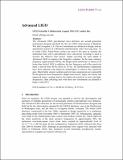Advanced LIGO
Author(s)
Aggarwal, Nancy; Barsotti, Lisa; Biscans, Sebastien; Bodiya, Timothy P.; Brown, N. M.; Buikema, Aaron; Essick, Reed Clasey; Isogai, Tomoki; Katsavounidis, Erotokritos; Lynch, Ryan Christopher; Matichard, Fabrice; Mavalvala, Nergis; Miller, John; Oelker, Eric Glenn; Tse, Maggie; Vaulin, Ruslan; Vitale, Salvatore; Weiss, Rainer; Wipf, Christopher C.; Yam, William; Zhang, Fan; Ray Pitambar Mohapatra, Satyanarayan; Shoemaker, David H; Zucker, Michael E; Fritschel, Peter K; Libson, Adam A.; MacInnis, Myron E; Mittleman, Richard K; Donovan, Frederick J; Evans, Matthew J; Gras, Slawomir; Mason, Kenneth R; ... Show more Show less
DownloadAdvLIGO_CQG_v6.pdf (6.592Mb)
OPEN_ACCESS_POLICY
Open Access Policy
Creative Commons Attribution-Noncommercial-Share Alike
Terms of use
Metadata
Show full item recordAbstract
The Advanced LIGO gravitational wave detectors are second-generation instruments designed and built for the two LIGO observatories in Hanford, WA and Livingston, LA, USA. The two instruments are identical in design, and are specialized versions of a Michelson interferometer with 4 km long arms. As in Initial LIGO, Fabry–Perot cavities are used in the arms to increase the interaction time with a gravitational wave, and power recycling is used to increase the effective laser power. Signal recycling has been added in Advanced LIGO to improve the frequency response. In the most sensitive frequency region around 100 Hz, the design strain sensitivity is a factor of 10 better than Initial LIGO. In addition, the low frequency end of the sensitivity band is moved from 40 Hz down to 10 Hz. All interferometer components have been replaced with improved technologies to achieve this sensitivity gain. Much better seismic isolation and test mass suspensions are responsible for the gains at lower frequencies. Higher laser power, larger test masses and improved mirror coatings lead to the improved sensitivity at mid and high frequencies. Data collecting runs with these new instruments are planned to begin in mid-2015.
Date issued
2015-03Department
Lincoln Laboratory; Massachusetts Institute of Technology. Department of Physics; LIGO (Observatory : Massachusetts Institute of Technology); MIT Kavli Institute for Astrophysics and Space ResearchJournal
Classical and Quantum Gravity
Publisher
IOP Publishing
Citation
Aasi, J, B P Abbott, R Abbott, T Abbott, M R Abernathy, K Ackley, C Adams, et al. “Advanced LIGO.” Classical and Quantum Gravity 32, no. 7 (March 3, 2015): 074001.
Version: Author's final manuscript
ISSN
0264-9381
1361-6382